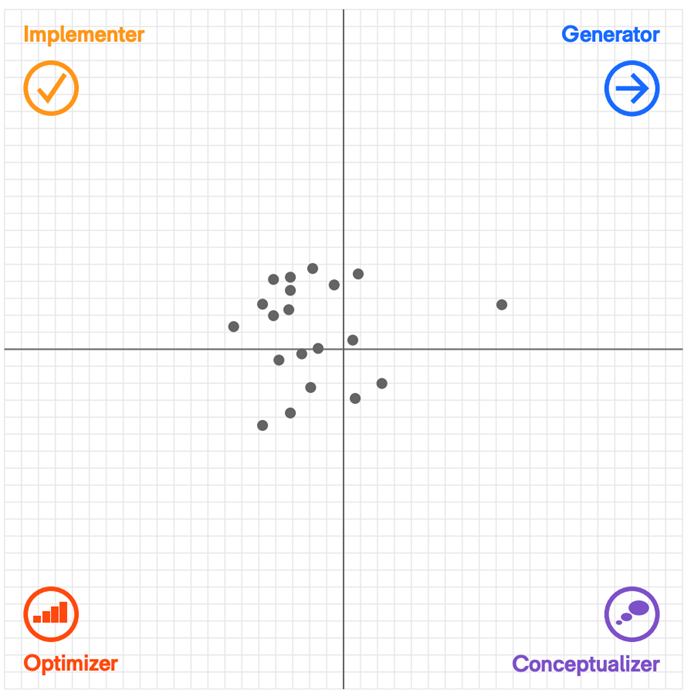Leveraging Cognitive Diversity: The Fear of Falling Behind
What do you do when innovation stagnates in your organization?
Overcoming Innovation Stagnation
This scatter diagram is from the archives. The story has a very happy ending as the company we profiled in this example has increased its share price 10x after years of stagnating. At the time, this was a typical team’s innovation style distribution at a major high-tech software company. Internally, they were very worried about falling behind, and with good reason. They were focused on making incremental improvements to their products (the n+1 business), often spending millions of dollars and human resources building and testing functionality that fewer than 1% of customers would ever use.
The higher up that you went inside the company, the more we encountered optimizers and implementers. Short-term fixes and quarter-end results were the name of the game. This created a culture focused on making continual, small improvements to its products and processes. With few people working to develop brand-new ideas or products, the company was vulnerable to being replaced by a more innovative competitor.
Today’s business world, especially high-tech, is littered with examples of hugely successful companies that rapidly lose their market share when newcomers remake the market with an innovative new product. Organizations in rapidly changing industries can’t afford to underestimate the importance of building teams that understand how to thoroughly and methodically work through the innovation process. Along with recruiting individuals who are enthusiastic about working on the generation and conceptualization stages of innovation, companies should use external facilitators, training, and incentives to embed an adherence to high-quality, process-driven innovation work into their workforces.
In utilizing the Basadur Profile, the company was able to identify this lack of generators and conceptualizers. With this knowledge, they focused on training team members to access and develop skills that will nurture the imbalance in these thinking styles. They changed their CEO who knew the key to long-term success was a culture change that bridged the gap between those people on the right side of the scatter diagram and the folks on the left. They started collaborating – engineers and designers working and innovating side-by-side rather than operating in silos.
Attributes of Generators include:
- Being able to think divergently.
- Having a high level of idea fluency, they produce numerous ideas quickly.
- Natural curiosity, they enjoy exploring new concepts and possibilities.
- Openness to uncertainty.
- Initiating creativity.
- Connecting seemingly unrelated concepts or ideas.
- Producing a large quantity of ideas.
Attributes of Conceptualizers include:
- Ability to synthesize information.
- Engaging in abstract thinking, looking beyond the concrete details.
- Having a visionary outlook, to see future possibilities.
- Focusing on the big picture.
- Being skilled at recognizing patterns and trends, to identify connections.
- Serving as a source of inspiration for innovative thinking.
By understanding and addressing the thinking preferences within an organization and implementing strategies to leverage each style’s strengths, a company can create a more innovative and dynamic work environment. Encouraging a culture of innovation involves addressing not only the lack of ideas but also ensuring that there is a supportive infrastructure for turning those ideas into tangible results.
The Basadur Profile is designed with the premise that individuals possess a combination of thinking styles (Generator, Conceptualizer, Optimizer, and Implementer) to varying degrees. The Profile is designed to capture the diversity of thinking preferences and strengths within a team, emphasizing the importance of a balanced team that can effectively navigate through the entire innovation process.
“You’re an innovator, you just don’t know it yet!” Learn more about the Basadur Profile and how it measures cognitive diversity to support your team in achieving innovative results.
“You’re an innovator, you just don’t know it yet!” Learn more about the Basadur Profile and how it measures cognitive diversity to support your team in achieving innovative results.
Ready to take The Profile?


